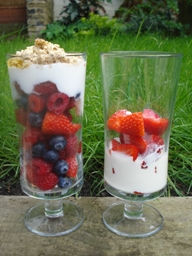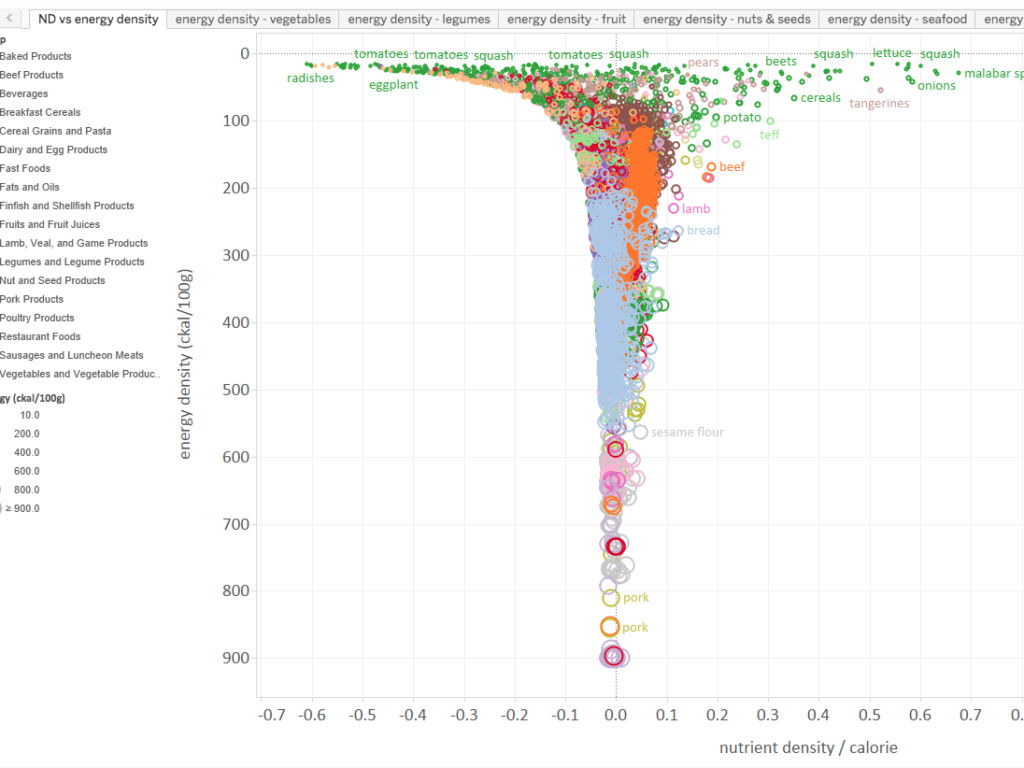There’s a very simple formula for losing weight. The total number of calories you consume from eating must just be less than the total number of calories you burn living and exercise. However, the problem with this is you need to eat enough to feel full so you don’t eat too much. Therefore, there are two key things to focus on when deciding what to eat:
- foods that have a low energy density (low on the energy density index)
- foods that make you feel full longer (high on the satiety index)
To understand energy (calorie) density, look at the picture below. Both desserts have the same amount of energy (calories) but the one on the left is heavier and contains more mass (grams) which would make you feel full longer.
To calculate the energy density of a particular food, divide the number of calories divided by the weight. So using the desserts above as an example, they both contain about 215 kcal, but the one on the left weighs 300 g while the one on the right only weighs 140 g. Therefore:
- The energy density of the dessert on the left (mixed berries, low fat plain yogurt and sprinkling of granola) = 215 kcal/300 g = 0.7
- The energy density of the dessert on the right (strawberries and cream) = 215 kcal/140 g = 1.5
So although the two desserts have a similar calorie content, the one on the left has a much lower energy density than the one on the right and so the portion is twice as much as the other dessert.
Very low energy density foods = less than 0.6 kcal/g
Low energy density foods = 0.6 to 1.5 kcal/g
Medium energy density foods = 1.5 to 4 kcal/g
High energy density foods = more than 4 kcal/g
This interactive analysis of nutrient density versus energy density using Tableau can give you an easy way to see which foods are low in energy density.
Examples of food energy densities by food type
Vegetables
On average, vegetables are very low in energy density.
| food | calories/100g | calories / g |
| Chinese cabbage | 16 | 0.16 |
| celery | 17 | 0.17 |
| lettuce | 17 | 0.17 |
| summer squash | 19 | 0.19 |
| radishes | 19 | 0.19 |
| rhubarb | 21 | 0.21 |
| mung beans | 26 | 0.26 |
| asparagus | 27 | 0.27 |
| bamboo shoots | 28 | 0.28 |
| cabbage | 30 | 0.3 |
| mushrooms | 30 | 0.3 |
| mustard greens | 30 | 0.3 |
| jalapeno peppers | 35 | 0.35 |
| turnip greens | 37 | 0.37 |
| okra | 37 | 0.37 |
| chives | 37 | 0.37 |
| winter squash | 39 | 0.39 |
| carrots | 39 | 0.39 |
| banana pepper | 39 | 0.39 |
| snap green beans | 40 | 0.4 |
| collards | 40 | 0.4 |
| onions | 41 | 0.41 |
| eggplant | 41 | 0.41 |
| broccoli | 42 | 0.42 |
| bell peppers | 43 | 0.43 |
| parsley | 44 | 0.44 |
| beets | 48 | 0.48 |
| seaweed (kelp) | 50 | 0.5 |
| peas | 51 | 0.51 |
| dill | 52 | 0.52 |
| Brussels sprouts | 52 | 0.52 |
| artichokes | 54 | 0.54 |
| kale | 56 | 0.56 |
| parsnip | 76 | 0.76 |
| sweet potato | 87 | 0.87 |
| sweet corn | 111 | 1.11 |
| pinto beans | 142 | 1.42 |
| thyme | 359 | 3.59 |
| shallots | 377 | 3.77 |
Fruit
On average, vegetables are very low in energy density.
| food | calories/100g | calories/g |
| honeydew melon | 40 | 0.4 |
| apples | 53 | 0.53 |
| cherries | 54 | 0.54 |
| orange | 55 | 0.55 |
| mandarin oranges | 59 | 0.59 |
| pear | 64 | 0.64 |
| litchis | 73 | 0.73 |
| grapes | 77 | 0.77 |
| figs | 82 | 0.82 |
| blueberries | 91 | 0.91 |
| passion fruit | 109 | 1.09 |
Grains and cereals
| food | calories/100g | calories/g |
| oatmeal | 67 | 0.67 |
| teff | 101 | 1.01 |
| rice noodles | 105 | 1.05 |
| millet | 118 | 1.18 |
| quinoa | 120 | 1.2 |
| spelt | 135 | 1.35 |
| oat bran bread | 264 | 2.64 |
| rice bran bread | 273 | 2.73 |
| rye bread | 282 | 2.82 |
Legumes
| food | calories/100g | calories/g |
| tofu | 112 | 1.12 |
| lentils | 118 | 1.18 |
| lima beans | 129 | 1.29 |
| navy beans | 143 | 1.43 |
| hummus | 175 | 1.75 |
Seafood
| food | calories/100g | calories/g |
| crab | 78 | 0.78 |
| crayfish | 78 | 0.78 |
| lobster | 84 | 0.84 |
| haddock | 85 | 0.85 |
| perch | 91 | 0.91 |
| snapper | 94 | 0.94 |
| oyster | 98 | 0.98 |
| abalone | 99 | 0.99 |
| cod | 99 | 0.99 |
| white fish | 102 | 1.02 |
| halibut | 105 | 1.05 |
| Pollock | 105 | 1.05 |
| whiting | 109 | 1.09 |
| haddock | 110 | 1.1 |
| shrimp | 113 | 1.13 |
| salmon | 122 | 1.22 |
| sturgeon | 129 | 1.29 |
| clam | 135 | 1.35 |
| tuna | 137 | 1.37 |
| mackerel | 149 | 1.49 |
| octopus | 156 | 1.56 |
| rainbow trout | 162 | 1.62 |
| swordfish | 165 | 1.65 |
| mussel | 165 | 1.65 |
| sardine | 202 | 2.02 |
| anchovy | 203 | 2.03 |
| herring | 210 | 2.1 |
| caviar | 276 | 2.76 |
Animal products
| food | calories/100g | calories/g |
| turkey breast | 127 | 1.27 |
| ham | 146 | 1.46 |
| pork | 154 | 1.54 |
| emu | 159 | 1.59 |
| chicken liver | 165 | 1.65 |
| beef liver | 169 | 1.69 |
| veal (leg) | 174 | 1.74 |
| chicken breast | 178 | 1.78 |
| beef | 197 | 1.97 |




